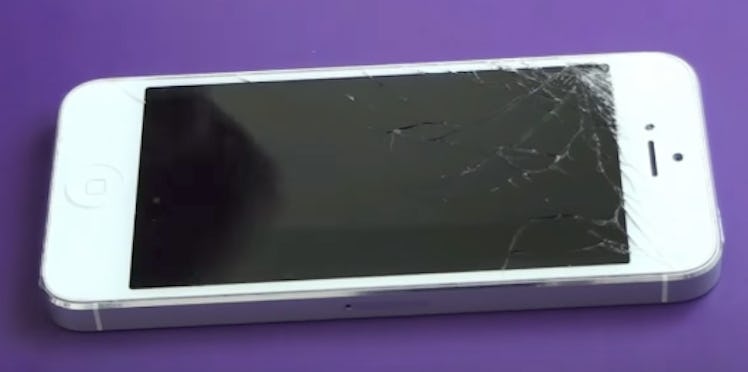
This Insane Invention Could Mean You'll Never Have A Shattered iPhone Screen Again
Dropping your smartphone is never a fun time. First, you unsuccessfully make a move to try and catch it. Then, your heart races during that panicked moment when you're about to pick up the remains and assess the damage. And finally, you realize that the only way to continue using your phone without getting glass splinters is to get it fixed for a good chunk of change or put it in a plastic baggie (embarrassing but it works). Soon, you won't have to worry about cracking your phone when it's dropped because future phones could be made from this new material that will stop your iPhone from shattering.
According to The Telegraph, scientists at the University of Sussex have found a new material with which to cover your iPhone, and it just might keep you from breaking into a nervous sweat the next time your phone accidentally falls out of your back pocket. Graphene and silver are the materials coming to the rescue of your beloved touchscreen. University of Sussex scientists discovered that these materials can be combined at a fraction of the cost of current touchscreen materials — indium tin oxide covered with glass — while still providing the same touchscreen performance.
Apparently the fragile nature of the current screen recipe is what makes your precious iPhone so prone to shattering when it drops. This alternative of graphene, which according to The Telegraph, is "a material made from a single layer of carbon atoms," can be combined with silver nanowires to create a much more flexible material that would not require a glass coating. What does that mean? Well, it means that your phone could be covered with a more flexible material as well, such as acrylic, which as The Telegraph puts it, is "far more bendy and less breakable."
It makes sense that more flexible materials should be used to cover your iPhone. I mean, I know that when I stretch and try to improve my flexibility, I also feel "far more bendy and less breakable." In all seriousness, this could be revolutionary for smartphones. You may have thought that silver would be expensive to use in your iPhone's touchscreen, but scientists figured out that only a very small amount of silver would be needed to achieve the desired result of a more durable touchscreen.
According to Professor Alan Dalton, who works in the school of Maths and Physical Science at The University of Sussex:
It would be relatively simple to combine silver nanowires and graphene in this way on a large scale using spraying machines and patterned rollers. This means that brittle mobile phone screens might soon be a thing of the past.
Not only could you reserve the use of plastic sandwich bags for, well, sandwiches, you might also be getting a higher performing touchscreen — along with lower production costs and the promise of greater durability. Higher performance and lower cost? Yes, please. o
Dalton continued to explain that "the addition of graphene to the silver nanowire network also increases its ability to conduct electricity by around a factor of ten thousand." If your physics brains isn't fully percolating yet, what that means in plain English is that your touchscreen could be "more responsive and use less power" when it's made with the graphene and silver. No more cussing at your phone when you've correctly keyed in your passcode five times, and it still won't open.
So, as you await the arrival of the flexible and durable graphene-silver touchscreen, you can also look forward even further into the future of smartphones — because Dalton gave clumsy iPhone users everywhere hope when he said that, "This paves the way towards one day developing completely flexible devices.”
Until then, keep your iPhone covered, and Snapchat your latte art with caution.
Check out the entire Gen Why series and other videos on Facebook and the Bustle app across Apple TV, Roku, and Amazon Fire TV.